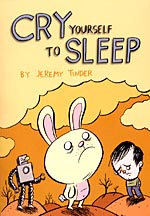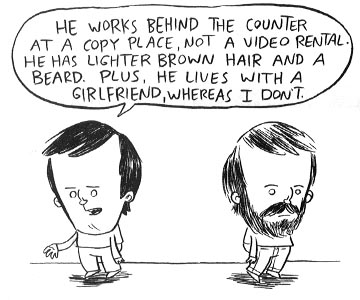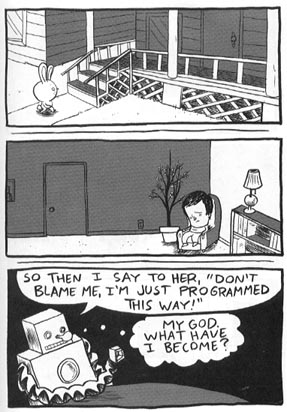 By Jeremy Tinder
By Jeremy Tinder
88 pages, black and white
Published by Top Shelf Productions
Some books sound like a punch line the second you begin to describe them. An aspiring novelist, a rabbit, and a robot seems like a strange combination from the very first second, but at no point does it seem like a set-up for a bad pun. Instead, we’re getting a strange little story about jobs and storytelling and souls and building nests. (That’s a not a set-up either.)
Jim’s a rabbit who gets bounced from one job to the next, each more dead-end than the one before. His roommate Andy is stuck at a video rental store even as he aspires to become a great novelist. The Robot wants to know where its soul has gone. But can any of them really find what they’re looking for?
 At a casual glance it’s easy to mistake Cry Yourself to Sleep as a number of different familiar genres of graphic novels that it actually doesn’t fall into. It’s easily confuseable for both autobiographical and all-ages books; it’s got a character that could be identified as a proxy for the author, it’s got adorable anthropomorphic animals and robots wandering around. Ultimately, though, it’s neither of those things. Cry Yourself to Sleep is Jeremy Tinder’s story about jobs and dreams and trying to survive in a more universal context. If you look at Tinder’s story it’s three characters who are all in positions that they don’t quite fit into. Jim is working jobs that he literally can’t fit into physically due to being a rabbit, be it the impossibility of wearing gloves or working the gas pedal of a truck. Andy is working a job to make ends meet while sending out his book manuscript, but the kind of book that he’s writing is both sub-par and a thinly disguised version of himself and Jim. And while the Robot’s profession is never mentioned, the insinuation is certainly there that the life that made it lose its soul has something to do with work. Maybe that’s why I thought the ending of Cry Yourself to Sleep was so interesting, because each character finds a different sort of solution to their dilemma. None of the endings of their stories are perfect, or even really ideal, but it’s something that seems to be working for them. They’re all still just figuring out exactly what they need to do.
At a casual glance it’s easy to mistake Cry Yourself to Sleep as a number of different familiar genres of graphic novels that it actually doesn’t fall into. It’s easily confuseable for both autobiographical and all-ages books; it’s got a character that could be identified as a proxy for the author, it’s got adorable anthropomorphic animals and robots wandering around. Ultimately, though, it’s neither of those things. Cry Yourself to Sleep is Jeremy Tinder’s story about jobs and dreams and trying to survive in a more universal context. If you look at Tinder’s story it’s three characters who are all in positions that they don’t quite fit into. Jim is working jobs that he literally can’t fit into physically due to being a rabbit, be it the impossibility of wearing gloves or working the gas pedal of a truck. Andy is working a job to make ends meet while sending out his book manuscript, but the kind of book that he’s writing is both sub-par and a thinly disguised version of himself and Jim. And while the Robot’s profession is never mentioned, the insinuation is certainly there that the life that made it lose its soul has something to do with work. Maybe that’s why I thought the ending of Cry Yourself to Sleep was so interesting, because each character finds a different sort of solution to their dilemma. None of the endings of their stories are perfect, or even really ideal, but it’s something that seems to be working for them. They’re all still just figuring out exactly what they need to do.
If that’s all Tinder put into Cry Yourself to Sleep then I’d have enjoyed the book, but there’s other bits in the writing that are sharp as well. Tinder’s sense of humor is an important part of the book, from the fake mustache scene in the video store to Jim’s various soliloquies where he does everything from miss the obvious money solution (while complaining about not having any), to lamenting having just spent the last of his money on “videogames and lapdances.” It’s a brief break here and there from the lives that threaten to push all three characters into despair, and it’s a nice touch. Likewise, the little hints of romance in Cry Yourself to Sleep are genuinely sweet; the scene in the video store with Andy’s crush in particular standing out as something that seemed at first to be very ordinary and then manages to tip the scale into really good.
 Tinder’s art is a cute, cartoonish style that helps defuse what could otherwise be a more depressing book. For instance, what could be a particularly low moment of Jim needing to go back to his parents’s home is simultaneously funny as he goes down a rabbit hole… where his rabbit mother and human father live together. Likewise, Andy’s defense of how his book isn’t a thinly disguised autobiography is made both perfectly clear (and really funny) when a mirror image of Andy stands next to him amidst the listing of differences between the two of them.
Tinder’s art is a cute, cartoonish style that helps defuse what could otherwise be a more depressing book. For instance, what could be a particularly low moment of Jim needing to go back to his parents’s home is simultaneously funny as he goes down a rabbit hole… where his rabbit mother and human father live together. Likewise, Andy’s defense of how his book isn’t a thinly disguised autobiography is made both perfectly clear (and really funny) when a mirror image of Andy stands next to him amidst the listing of differences between the two of them.
There’s also some nice storytelling going on in Cry Yourself to Sleep. Tinder plays a bit with format early on when he introduces our three protagonists; after the opening sequence with Jim plays out across entire pages, it shrinks down to the top third of the book while Andy’s introduction takes up the bottom two thirds. Then, after a few pages, Andy’s shrinks down to the middle third and the Robot is introduced, even as all three stories continue to play out across the pages. It’s a nice little trick that really works best in comics, and at the same time Tinder knows not only how to use it but when to stop using it before the device gets tired. The easy-to-follow three-row format of the comic keeps the book accessible and moving at a good pace, while allowing Tinder to easy choose from one to six panels on each page while not breaking with the structure he’d set up. It’s an extremely attractive book from start to finish, and Tinder makes sure that it’s instantly appealing to the eye.
Cry Yourself to Sleep was a nice surprise waiting for me on a day when I needed a good pick-me-up. It’s a solid debut for Tinder, and he shows real promise as a creator, already understanding how to really use the medium of comics to tell a story. It’s always refreshing to see new talent in comics produce such strong books out of the gate. I’ll definitely keep my eyes open for future comics from Tinder.
Purchase Links:
